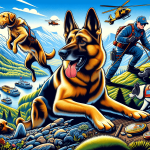
Humans, dogs and hunting have a relationship that is well-known and goes way back. Dogs were among the first few animals that were domesticated by humans. It was almost 14,000-20,000 years ago when pre-historic men decided to partner up with their canines for hunting. Archeological evidence suggests that the close proximity of several species of wolves, coyotes and jackals to human settlements led to the domestication of dogs.
Dogs were an excellent aid to early humans as they would mitigate the factors which would result in losing hold of their prey. Otherwise, humans would ultimately have difficulty surviving. Dogs helped hunt both small and large prey by tracking them down through blood trails and forcing their targets into inescapable positions, making hunting easier for humans.
It was the time when humans depended most on hunting for survival as other ways to acquire food (for instance, agriculture) hadn’t been invented yet. This partnership of humans and dogs for hunting is believed to have begun around the time when humans had just started to organize themselves and were becoming more intelligent.
11,500-Year-Old Human Settlement
There are numerous studies that corroborate this hunting companionship of dogs. According to a new study of animal bones collected from an 11,500-year-old settlement called Shubayqa 6 in northeast Jordan, there were signs of bones being passed through the digestive tract of another animal. These bones were so large that they possibly couldn’t have been swallowed by humans but must have been digested by dogs. The study also revealed that dogs were integrated in the day-to-day aspects of life and were not just kept at the fringes of the settlement to only be used during hunting.
The studies have revealed not only the hunting capabilities of early dogs but their extraordinarily heightened senses as well that may have aided the Neolithic humans. According to a study conducted by Angela Perri, breeds of early dogs like Bloodhounds and Shiba Inu not only helped track down the prey, but they also warned their owners of the presence of boars in the area.
The early humans believed that their dogs were a domesticated type of wolves that was efficient at sighting and flushing out the target. Fogs would often keep on chasing their prey in order to make them collapse from exhaustion and then humans would finish them off by using their spears, knives or other weapons.
Evolution of the Relationship Between Humans and Dogs
With the evolution of humans and their ways to survive and thrive, the function of dogs changed from that of hunters to helpers and protectors. That happened when livestock was domesticated and humans began harvesting. This led to the change in roles of early dogs. During this time, dogs were specifically bred according to the environment and climate to cater to human needs.
Egyptians are believed to be the first group of humans who began breeding dogs, especially for hunting purposes. They would breed and use dogs that were extremely large and a good fit for hunting a diverse range of animals, which included large targets too. They highly valued their dogs for their polished spotting and sourcing skills.
Romans and Greeks also began investing their time and resources into breeding dogs to hunt with. As humans changed, so did their hunting styles and soon, hunting with dogs became a leisure sport for them. This activity became widespread throughout the Middle Ages, which resulted in breeds of highly specialized dogs as they were being bred for different purposes.
The Descendants
Today, there are hundreds of breeds that trace back to the ancient dogs and within each type, there are different categories with distinct characteristics. There are specific hunting breeds, each with its own traits and set of behaviors that vary greatly from other categories. For instance, some dogs have a heightened sense of smell, which is helpful in recovering lost members of flocks or in tracking predators. The three main categories of hunting dogs are as follows:
Hounds
Most breeds in this group have a strong sense of smell and a loud voice, which they use to keep the prey in a vulnerable position. All breeds are almost similar in their pursuit of the target, but they are specifically bred to pressure their prey into submission. Its subcategories include scent hounds and sighthounds.
Gun Dogs
Their purpose is to locate the prey after it has been shot down. The category is further divided into pointers, retrievers and flushers.
Terriers
These breeds have been turned into house pets, but in the old times, they would be bred to hunt small animals such as vermin.
Following are a few breeds that have established extremely strong bloodlines:
Sighthounds & Scent Hounds
These breeds have a heightened sense of sight and smell to locate and track their prey. Back in the early times, these dogs were mostly used for hunting purposes.
Retrievers
This type of dog is used for retrieving birds after they have been shot down. These dogs have webbed feet and water-repellent coats, which enable them to swim quickly.
Pointers
As the name suggests, this breed was bred to identify, locate and point out prey. It has a keen sense and is able to locate even the most disguised target.
Since the dawn of mankind’s existence, hunting has been the basic necessity to survive and thrive. Early dogs helped in hunting and remained loyal to their human counterparts for years to come, but with evolution, the hunter dogs morphed into helpers and protectors. In fact, in today’s age, the practice of hunting with dogs is taken more as a sport and is considered rather controversial. Although dogs are more pets now rather than hunters, the companionship of a human and dog still persists. Dogs are still considered a loyal friend who humans can depend on.









